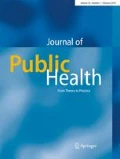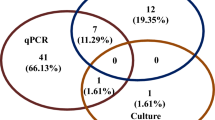Abstract
Aim
Typhoid fever is a serious health problem in tropical and developing countries. Although asymptomatic typhoid carriers show no clinical signs, they can spread infection to others. This study investigated the Toll like receptor 5 (TLR5) polymorphism and various clinical parameters in typhoid patients and asymptomatic typhoid carriers.
Subjects and methods
TLR5 gene was amplified in typhoid patients (n = 15), asymptomatic carriers (n = 10) and healthy control subjects (n = 10) by polymerase chain reaction (PCR). A restriction fragment length polymorphism (RFLP) analysis of TLR5 gene was performed with restriction enzyme (Ddel). Clinical parameters such as total leukocyte, platelets, C-reactive protein (CRP), and adenosine de-aminase (ADA) were estimated. A correlative analysis of TLR5 gene polymorphism and clinical parameters was performed.
Results
Typhoid fever patients had significantly (p < 0.05) reduced total leukocyte and platelet counts when compared to asymptomatic carriers and control subjects. Typhoid patients showed significantly (p < 0.05) reduced ADA activity, while elevated CRP level when compared to carriers and controls. TLR5 gene was amplified in all individuals, but only two typhoid patients showed TLR5 gene polymorphism (TLR5 392STOP). There was no significant correlation between TLR5 gene polymorphism and clinical parameters studied in typhoid patients.
Conclusion
The TLR5 gene polymorphism seems to be not associated with susceptibility to typhoid fever.






Similar content being viewed by others
Abbreviations
- TLR5 :
-
Toll like receptor 5
- RFLP:
-
Restriction fragment length polymorphism
- PCR:
-
Polymerase chain reaction
- CRP:
-
C-reactive protein
- ADA:
-
Adenosine de-aminase
- SNPs:
-
Single-nucleotide polymorphisms
- TCS:
-
Total clinical scores
References
Ali S, Vollaard AM, Kremer D, de Visser AW, Martina CA, Widjaja S et al (2007) Polymorphisms in proinflammatory genes and susceptibility to typhoid fever and paratyphoid fever. J Interferon Cytokine Res 27:271–279
Brecher G, Cronkite EP (1950) Morphology and enumeration of human blood platelets. J Appl Physiol 3:365
Buckle GC, Walker CLF, Black RE (2012) Typhoid fever and paratyphoid fever: systematic review to estimate global morbidity and mortality for 2010. J Glob Health 1(2):010401. doi:10.7189/jogh.02.010401
Dunstan SJ, Stephens HA, Blackwell JM, Duc CM, Lanh MN, Dudbridge F et al (2001) Genes of the class II and class III major histocompatibility complex are associated with typhoid fever in Vietnam. J Infect Dis 183:261–268
Dunstan SJ, Hawn TR, Hue NT, Parry CP, Ho VA, Vinh H et al (2005) Host susceptibility and clinical outcomes in toll-like receptor 5-deficient patients with typhoid fever in Vietnam. J Infect Dis 191(7):1068–1071. doi:10.1086/428593
Dunstan SJ, Nguyen TH, Rockett K, Forton J, Morris AP, Diakite M et al (2007) A TNF region haplotype offers protection from typhoid fever in Vietnamese patients. Hum Genet 122:51–61
Gabay C, Kushner I (1999) Acute-phase proteins and other systemic response to inflammation. N Engl J Med 6:448–454
Gewirtz TA, Kumar AV, Brant SR, Duerr RH, Nicole DL, Cho JH (2006) Dominant-negative TLR5 polymorphism reduces adaptive immune response to flagellin and negatively associates with Crohn’s disease. Am J Physiol Gastrointest Liver Physiol 290:G1157–G1163
Hawn TR, Verbon A, Lettinga KD, Zhao LP, Li SS, Laws RJ et al (2003) A common dominant TLR5 stop codon polymorphism abolishes flagellin signaling and is associated with susceptibility to legionnaires’ disease. J Exp Med 198:1563–1572
Hayashi F, Smith KD, Ozinsky A, Hawn TR, Yi EC, Goodlett DR et al (2001) The innate immune response to bacterial flagellin is mediated by Toll-like receptor 5. Nature 410:1099–1103
Heiserman DL (2004) Methods of hematology, 4th edn. Sweet Haven, Columbus, OH, 23–27 pp
Hong-Ren YU, Jiunn-ming S, Kao-pin HO (2008) Typhoid fever in southern Taiwan: a medical center experience. Pediatr Neonatol 49:116–120
Hosoglu S, Aldemir M, Akalin S, Geyik MF, Tacyildiz IH, Loeb M (2004) Risk factors for enteric perforation in patients with typhoid fever. Am J Epidemiol 160(1):46–50. doi:10.1093/aje/kwh172
Jeffrey LE, David C (2000) Acute-phase reactants in infections and inflammatory diseases. Periodontology 23:19–49
Khosla SN, Kumar D, Singh V (1992) Lymphocytic adenosine deaminase activity in typhoid fever. Postgrad Med J 68:268–271
McSoreley SJ, Ehst BD, Yu Y, Gewirtz AT (2002) Bacterial flagellin is an effective adjuvant for CD4+ T cells in vivo. J Immunol 169:3914–3919
Mishra OP, Gupta BL, Ali Z, Nath G, Chandra L (1994) Adenosine deaminase activity in typhoid fever. Indian Pediatr 31(11):1379–1384
Okafor AI (2007) Haematological alterations due to typhoid fever in Enugu Urban-Nigeria. Malays J Microbiol 3(2):19–22
Raffatellu M, Wilson RP, Winter SE, Baumler AJ (2008) Clinical pathogenesis of typhoid fever. J Infect Developing Countries 2(4):260–266
Rajendranath R, Edecio CN, Kellen C, Susan F (2009) Heterozygosity for the S180l variant of MAL/TIRAP, a gene expressing an adaptor protein in the toll-like receptor pathway, is associated with lower risk of developing chronic Chagas cardiomyopathy. J Infec Dis 199:1838–1845
Sarah JD, Thomas R, Nguyen TH (2005) Host susceptibility and clinical outcomes in toll-like receptor 5-deficient patients with typhoid fever in Vietnam. J Infec Dis 19:1068–1071
Sasikumar C, Kannan V, Senthilkumar B (2005) Asymptomatic typhoid carriers in Namakkal District Tamil Nadu. J Environ Biol 26:113–115
Senthilkumar B, Prabakaran G (2005) Multidrug resistant Salmonella typhi in asymptomatic typhoid carriers among food handlers in Namakkal District Tamil Nadu. Ind J Med Microbiol 23(2):92–94
Senthilkumar B, Senbagam D, Rajasekarapandian M (2012) An epidemiological surveillance of asymptomatic typhoid carriers associated in respect to socioeconomic status in India. J Pub Health. doi:10.1007/s10389-012-0545-4
Uberti J, Johnson RW (1976) Decreased lymphocyte adenosine deaminase activity in tumor patients. Cancer Res 36:2046
Yap PK, Chua CT (1983) The haemogram in the diagnosis of acute typhoid fever: with special reference to thrombocytopenia. Singapore Med J 24:161–162
Yoshitsugy H (1987) Estimation of C-reactive protein levels by semi-quantitative slide test. J Clin Lab Status 1:15–27
Acknowledgements
Authors are thankful to Muthayammal College of Arts and Sciences for providing the facilities through the research scholars grant to carry out this study. Authors are also thankful to Ms. Helen England for her critical evaluation in the preparation of the manuscript.
Conflict of interest
The authors declare that they have no conflict of interest.
Author information
Authors and Affiliations
Corresponding author
Rights and permissions
About this article
Cite this article
Senthilkumar, B., Sivakumar, P., Madhanraj, R. et al. A comparative analysis of TLR5 polymorphism and clinical parameters in typhoid patients and asymptomatic typhoid carriers. J Public Health 22, 131–137 (2014). https://doi.org/10.1007/s10389-013-0604-5
Received:
Accepted:
Published:
Issue Date:
DOI: https://doi.org/10.1007/s10389-013-0604-5



